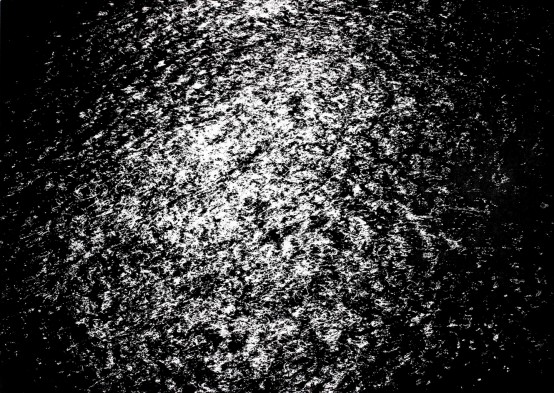Printmaking
Sparkling Dark
The new series of works by Mary Schina appears to shift from her earlier view of light and nature. Until recently, her interest was focused more on rendering light through colour, through its transparency and movement, and its relationship with the differing surfaces – especially that of the sea – on which the light came to rest.
In this series entitled Sparkling Dark, Schina has added another stage to the printmaking process by choosing to use aquatint to process her own black and white digital photographs that were all taken in summer near the sea, at night and under a full moon.
This different method of treating the photos confronts her with two challenges. First, she now has to work with the impressions created by light without the intervention of colour, with which she has worked almost exclusively in recent decades. Second, by selecting black and white photography, she returns to the primary imperative of printmaking to the relationship between white and black. Specifically, the creative process she has selected for transferring photographs and intervening artistically onto digital files, has all the features of disciplined meditation: her observation of the reflections made by the radiant light of a full moon on the water, waiting for just the right moment, the successive shot that become instant variations on a theme that keeps transforming from moment to moment, the demanding digital intervention and, of course, her selection of aquatint as the most appropriate method for creating the work.
The compositions under full moon lie somewhere between impression and feeling. After being selected, the photographs become the canvas that generates the next stage, in which Schina begins her intervention, using printmaking to transform random images into artistic compositions. Special imaginative power is required for one to “see” the white-black of the photograph being transformed into the white-black of the printmaking, a metamorphosis that presupposes both considerable experience in the printmaking methods, thus making it possible to transform a random impression into a specific theme and, above all, the creative self-confidence that clearly pre-determines the visual outcome.
Aquatint produces a particularly dense, radiant black that contrasts with the absolute white of the light, while virtually no intermediate tones can be discerned in the works. Nonetheless, the transition from dark to light is not abrupt; on the contrary, in this transition, the white surfaces appear gradually through the black, without creating gray surfaces. The aquatints in this series combine Schina’s personal confidence in the result, her trust in homogeneous as well as contrasting patterns, and above all, her artistic approach that isolates and utilizes the qualities of a photograph in conjunction with the potential offered by an exacting traditional printmaking method.
Irene Orati, Art Historian
